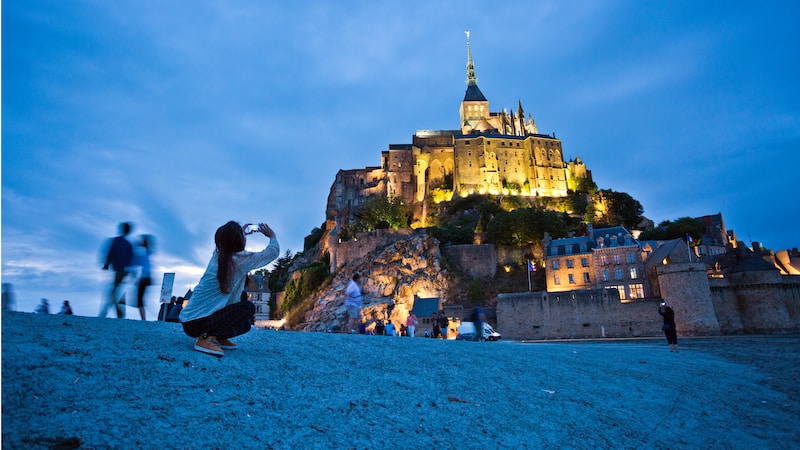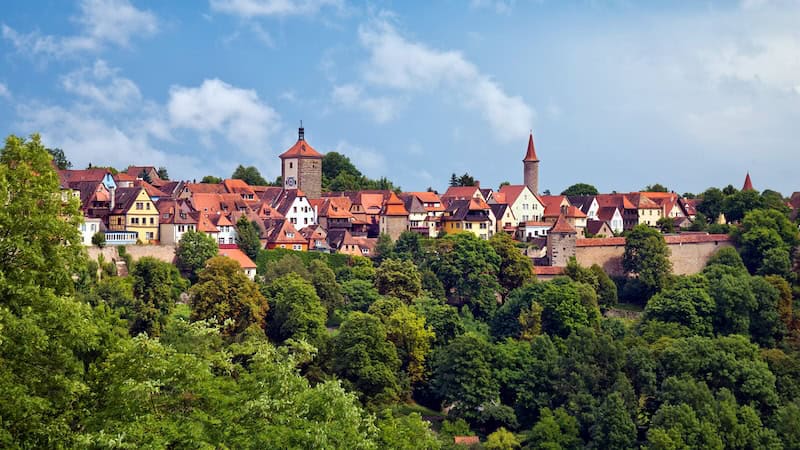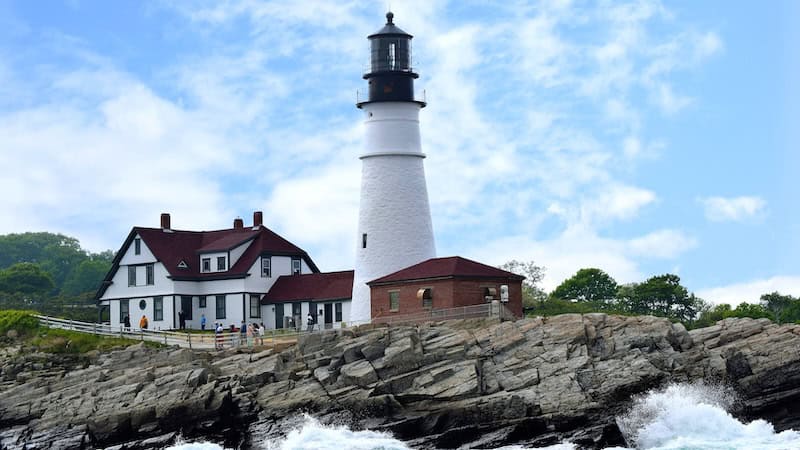Mont St-Michel: Hermits and Omelets
Normandy’s magnificent island abbey

The towering abbey of Mont St-Michel rises above the surrounding landscape – which becomes a waterscape at high tide. Traveler Rick Steves takes us to the historic island abbey with its rich history, traditional omelets, and a man-powered treadwheel.
I love to scamper, at low tide, shoes in my hands, far from shore, across the mudflat in the vast Bay of Mont St-Michel. Splashing across black sand and through little puddles, I head for a dramatic abbey reaching to heaven from a rock surrounded by a vast and muddy solitude.
Since the sixth century, hermit monks in search of that solitude lived here. Location, location, location. The word “hermit” comes from an ancient Greek word meaning “desert.” The next best thing to a desert in this part of Europe was here.
Imagine the “desert” this bay provided as the first monk climbed the rock to get close to God. Mix in the mythic tide, which sends the surf speeding eight miles in and out with each tide cycle. Back then, before a causeway and later a bridge was built, Mont St-Michel was an island. Pilgrims would approach across this mudflat mindful of a tide that swept in “at the speed of a galloping horse” (well, maybe a trotting horse … 12 mph, or about 17 feet per second).
Quicksand, the thoroughly disorienting fog, and the fact that the sea can encircle unwary hikers added to the peril. Braving these devilish risks for centuries, pilgrims kept their eyes on the spire crowned by their protector, St. Michael, and eventually reached their spiritual goal.
Whether scampering across the treacherous mudflats or riding a shuttle bus across the modern bridge, the sight of the distant silhouette of the Gothic island-abbey Mont St-Michel sends tired sightseers’ spirits soaring today just as it did the spirits of weary pilgrims in centuries past.
Though a dreamscape from a distance, through the midday Mont St-Michel becomes grotesquely touristic. In summer, Mont St-Michel’s main street, lined with shops and hotels leading to the abbey, can be a human traffic jam. It’s some consolation to remember that, even in the Middle Ages, this was a commercial gauntlet, with stalls selling souvenir medallions, candles, and fast food. Today, the village’s seven full-time residents continue to live solely for its visitors.
While on Mont St-Michel, indulge in some local culinary treats: mussels, seafood platters, lamb (fed on the local saltwater grass), and inexpensive Muscadet wine. Puffy omelets are the island’s specialty. For touristy fun, poke your head into Restaurant La Mère Poulard on the main drag. In their theater-kitchen, old-time-costumed cooks beat traditional omelets – creating a fun rhythm that can be heard many doors away. The quick omelets were popular for pilgrims who, before the island was connected to the mainland, needed to beat the tide to get out. And – even at today’s rip-off prices – they’re still a hit with 21st-century tourists.
The actual abbey of Mont St-Michel is the reason to visit. It’s been an important pilgrimage center since AD 708, when (according to legend) the Archangel Michael told the local bishop to “build here and build high.” With uncanny foresight he reassured the bishop, “If you build it … they will come.” Saint Michael, whose gilded statue decorates the top of the abbey’s spire, was the patron saint of many French kings, making this a favored sight for French royalty through the ages.
Today’s abbey is built on the remains of a Romanesque church, which was built on the ruins of a ninth-century Carolingian church. Visiting the abbey, imagine the headaches and hassles the monks had when they built it. They ferried granite from across the bay and hiked it uphill.
A walk in the abbey is a one-way route through fine – but barren – Gothic rooms. A rented audio guide or English-language tour make this historic sight more meaningful. Visitors may explore the impressive church, delicate cloisters, and refectory (where the monks ate in austere silence), and then climb down into the dark, damp Romanesque foundations. A highlight is the giant treadwheel, which six workers once powered hamster-style to haul two-ton loads of stones and supplies from the landing below. This was used until the 19th century.
From the abbey’s veranda, survey the bay stretching from Normandy to Brittany. The river below marks the historic border between the two lands. Brittany and Normandy have long vied for Mont St-Michel. In fact, the river used to pass Mont St-Michel on the other side, making the abbey part of Brittany. Today, the river’s route is stable and the abbey is just barely – but thoroughly – on Norman soil.
Hang out until after dark when the tourists are gone and the island is magically floodlit. Ramble on the ramparts. Ponder the promise of desolation and a simple life of solitude that attracted monks to this dramatic spot so long ago.
PHOTO CAPTION, ABOVE: Christian pilgrims and tourists are drawn to the dramatically situated Mont St-Michel, a soaring island abbey in Normandy that is completely surrounded by the sea at high tide. CREDIT: Rick Steves.

Explore more of Rick Steves’ Europe in Boomer
©2023 RICK STEVES
As an Amazon Associate, Boomer Magazine earns from qualifying purchases of linked books and other products.



